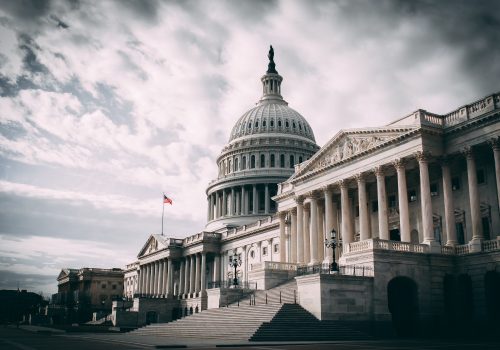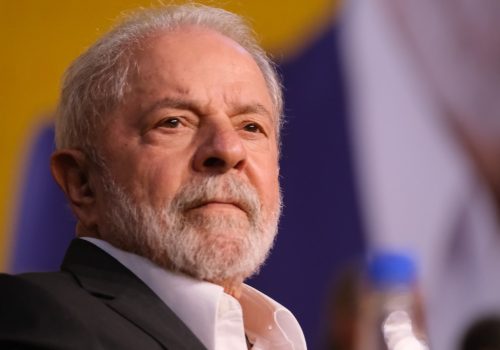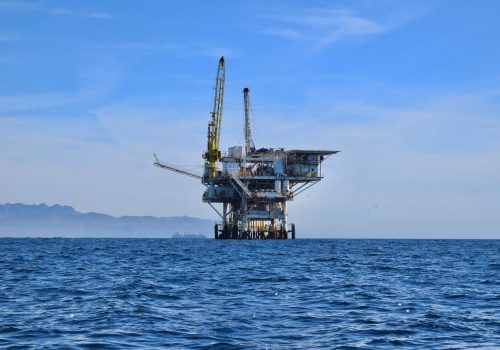Guyana is on a rapid path to a major transformation in national wealth. A total of forty-six offshore oil discoveries have been found since exploration commenced in 2015, with an estimated 11 billion barrels of recoverable oil and gas in the offing. Industry experts project that by 2035, Guyana’s output could reach 1.7 million barrels of oil per day, which would make it the fourth largest oil producer in the world.
As a result of the transformative influx of natural resource wealth into Guyana’s emerging economy, the World Bank recently reclassified Guyana as a “high income” country on the basis of its gross national income. The country’s per capita GDP rose from $6,863 in 2020 to $18,990 in 2022; and it is projected to reach $35,900 by 2027. Recent estimates suggest that the Guyanese government could soon see $10 billion annually in revenue from the country’s oil resources, perhaps rising to $157 billion by 2040.
Successive governments have worked hard to try to protect Guyana from the fate that has befallen most countries that have seen major increases in resource wealth. The so-called “Resource Curse” is the unfortunate decline in human development and civil society which often befalls countries with exceptional resource wealth. These outcomes are often connected to overvaluation of the exchange rate, atrophy of non-extractive industries, the disconnection between government and citizens that takes place when governments are funded from resource rents rather than taxation, poorly planned and executed spending and, too often, systemic corruption. The sad reality is that only a handful of countries that depend primarily on an extractive industry for national income—such as Botswana, Norway, Chile, and Malaysia—have avoided the “curse.”
In some instances where governments seek outside expertise, the US government has offered technical assistance to mitigate or prevent these outcomes. When I served in the State Department in the early days of the Obama administration, we created an Energy Governance and Capacity Initiative. Its purpose was to identify potential oil and gas producers, then leverage the expertise of the Treasury Department, Interior Department, and USAID to equip new regulatory bodies to manage resource rents. This support encouraged new producers to develop strong regulatory frameworks to govern their new industries before resource development brought in resource rents.
I visited Guyana in 2010 with an interagency team to offer that assistance to then President Bharrat Jagdeo. I returned this month, thirteen years later, on a trip supported by the Centre for Local Business Development, a backer of small-business development in Guyana that receives funding from the consortium of companies engaged in offshore oil and gas production in the country. It was both fascinating and instructive to learn how the country has evolved.
There have been a number of impressive accomplishments, made all the more commendable given the brief timeframe that Guyana has been allotted by circumstances to prepare for a massive influx of resource wealth. Guyana’s headline policies recognize the risk of the curse with sharp clarity and aim to chart a different path. The Natural Resource Fund (NRF) stewards resource rents, caps the amounts that can be used for the national budget and publishes inflows and outflows. A new regulatory reform law aims to make it easier to launch a business. The passage of the Petroleum Activities Bill earlier this year modernized the management of the oil and gas sector.
Similarly, a local content law and policy aims to ensure that Guyanese citizens have a major share of the jobs that will be produced and that Guyanese companies are preferred in forty or so categories where the required capacity and skills are available. Guyana has established an Extractive Industries Transparency Initiative program and, after some negotiations, is on a path to report the reconciliation of company payments with government income. There are robust plans to invest in the Guyanese people through roads, bridges, health, education, and power generation, and to diversify the economy by promotion of agriculture and eco-tourism. These are important, impressive, and laudable steps for phase one of a resource boom.
Looking ahead, President Irfaan Ali’s administration has an opportunity to establish a historic legacy for equitable and efficient growth. There is a clear chance to ensure Guyana joins a very short list of countries that have avoided the “curse” by launching phase two of Guyana’s national development strategy before the steep rise in income arrives in 2027. Six steps are critical:
1. Independent professional management of the natural resource fund. The most successful funds, like Norway’s Government Pension Fund and the UAE’s trio of sovereign wealth funds, insulate their governments from the temptation of risky investments or favoring their preferred partners by independent management. The government appoints a chair of the fund, and national legislation sets the fiscal rules, but the committee is constituted by management professionals charged with maximizing returns. Such a step would support the current and future Guyanese governments and offer a powerful signal of transparency to the citizenry and the investment community.
2. Establish civil service protections and scale up staff. The ministries responsible for managing the oil, gas, and mining industries are understaffed, underpaid, and significantly populated by contract employees and political appointees. Government jobs are therefore high risk (compared to the private sector), and staff are structurally disincentivized to express professional disagreement to political appointees. The country needs deep and stable expertise to fulfill its role in monitoring and regulating the extractive sector. It needs to establish significantly greater capacity (personnel and otherwise) to plan and manage procurement and then monitor the massive public expenditure to come. Civil service reform would be a signal of stability to investors in all industries. One need only look to Norway’s Petroleum Directorate or Brazil’s National Agency for Petroleum, Natural Gas and Biofuels for examples of professional regulators that provide stable investment climates even when political winds shift dramatically.
3. Provide a long-term national development plan. The reality for Guyana is that it will take time, perhaps a decade, to make progress in all the areas announced for development. Citizens are already demanding to see the benefits of the oil boom before the government has the scale of resources it needs to invest. The government might address those legitimate aspirations by announcing a roadmap for national development, with clear priorities and timelines. Planning for national infrastructure such as a national transmission backbone or road system is an extensive process. It can take years to identify routes, address local impact, consider environmental impact and plan for tenders. These efforts should commence immediately.
4. Create the conditions for high quality spending. A major characteristic of the resource curse is poor procurement and uncoordinated spending. Major projects can be steered to unqualified bidders who produce substandard work or often no work at all. Governments need to create the capacity, or hire it, to establish pre-qualification of bidders, fair and open tenders, and then active monitoring that the work is being done at the standards required. Guyana’s government should prioritize developing this capacity, which would assure both citizens and investors that Guyana’s major procurements will meet international standards of quality and transparency.
5. Refresh local content policy. Guyana has wisely established a local content law and a professional secretariat tasked with implementing it. It could evolve in three important ways. First, it needs to include the major tender and procurements for national infrastructure, which are likely to be far greater generators of local jobs than the oil and gas sector. Second, Guyana might examine whether the 51 percent ownership requirement is working. Majority ownership can deter investors if a country lacks partners with the capital to fund their share. Some investors will not risk sharing their best technology without a controlling interest. In some countries a 51 percent requirement is a corruption risk, as “paper owners” who do not really participate in the business sell their name to satisfy a legal requirement. It may be possible to adjust the local content requirements to center workforce training and continuing education, and thus provide ongoing benefits to the Guyanese people. Guyana also might emphasize vocational training (and appropriate wages) for the vast array of local technicians and tradespeople who will have leading roles in transforming their country.
6. Provide financing support for Guyanese businesses. The greatest challenge faced by Guyanese businesses seeking to participate in local content development is the lack of access to financing for short term cash flow or borrowing of equipment. Guyana’s banking system requires physical collateral, like real estate, to borrow. This blocks new market entrants and potential local entrepreneurs. Lack of financing risks undermining the entire local content effort. It may also foster resentment or worry in the business community that it will be unable to participate in the growth of the economy. There can be multiple solutions for this challenge, including creative banking regulations and creative financing options, such as a Guyanese version of the US Small Business Administration or some national enterprise fund.
Guyana has achieved a great deal in an astonishingly short space of time. Now, the government has an opportunity to show the world how to do resource development right. The core elements to its ongoing success are an inclusive, well-planned, carefully monitored and properly staffed effort to promote diversified national development. The Ali administration can create a lasting national, and international, legacy by taking the steps needed to ensure Guyana’s wealth is stewarded well. Many of the steps they must take may not pay benefits until far in the future, but that is how legacy is made. Guyana’s external friends like the United States, Canada, the UK, and the European Union should stand ready to support the Guyanese government if and when assistance is requested. The Ali administration is right to expect patience from its friends and citizens, but the time is ripe to launch phase two of Guyana’s governance.
David L. Goldwyn served as special envoy for international energy under President Obama and assistant secretary of energy for international relations under President Clinton. He is chair of the Atlantic Council’s Energy Advisory Group and a nonresident senior fellow with the Council’s Global Energy Center.
Meet the author
Related content
Learn more about the Global Energy Center

The Global Energy Center develops and promotes pragmatic and nonpartisan policy solutions designed to advance global energy security, enhance economic opportunity, and accelerate pathways to net-zero emissions.
Image: Oil rig (cclark395, flickr) https://www.flickr.com/photos/cclark395/11486522113





